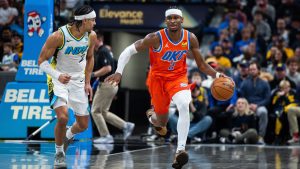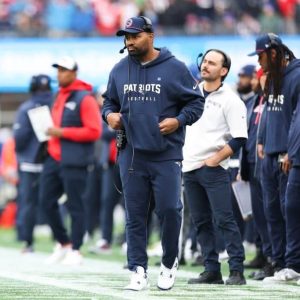Let’s take a look at which teams are in need of making a move, and how they should approach the trade deadline.
Midseason is quickly approaching, forcing teams to take serious stock of their rosters and direction.
The decisions to be made, right or wrong, fuel NBA fan interest, as the league’s transaction game remains an area of significant attention.
As such, let’s take a look at how teams from the Pacific Division should approach the Feb. 6 trade deadline.
Previous divisions: Atlantic | Central | Southeast | Northwest
Golden State Warriors
Status: Competitive
Approach: Clearly buyers
The Warriors got out ahead of us on this one, as they already traded for point guard Dennis Schröder via the Brooklyn Nets, relinquishing the contract of De’Anthony Melton, who is out for the year, as well as modest draft compensation.
Schröder, due to the fact that he was traded before Dec. 16, can actually get aggregated into a new trade if the Warriors wish to make a big play for a star such as Miami’s Jimmy Butler.
This isn’t to suggest the Warriors are thinking that big, but they’re clearly looking to add talent before the deadline to optimize Stephen Curry’s remaining prime.
It’s a commendable mindset given Curry’s role within the franchise, particularly when you consider he’s 36, and the loss of Klay Thompson last summer could easily have been enough to warrant a pivot toward a rebuild.
Instead, the Warriors seem hell bent on squeezing out the maximum value of Curry’s last few years, and it’s hard to disagree with that approach.
Likelihood of trade: Considering they’ve already made one, it’s obviously pretty substantial.
Los Angeles Clippers
Status: Competitive
Approach: Flexible
The Clippers were widely expected to be bad this season because of Kawhi Leonard’s injury status. Surely an aging group couldn’t pick itself up and deliver a winning product.
Well, the joke’s on the non-believers because that’s exactly what the Clippers have done due to career years from Norman Powell and Ivica Zubac.
The team is currently playing with house money, so it’s difficult to peg it as a team that’s trying to go for it, or one that could be using this winning situation to extract more assets in return for some of their players.
The last part would be clever, but it doesn’t seem like that would fit the Clippers’ motive, given their new arena. Clippers owner Steve Ballmer actively wants a winning product, and he doesn’t want the debut season of the Intuit Dome to be a losing one.
As such, it stands to reason the Clippers either stay the course, or act as buyers. Adding talent won’t necessarily be easy given their general lack of available assets, so let’s assume they just try to keep the current train moving.
Likelihood of trade: Small
Los Angeles Lakers
Status: Competitive
Approach: Buyers
While it’s certainly possible to make a case for the Lakers entering the deadline period as sellers due to their wonky roster, odds are good they’ll be going in the opposite direction.
It makes sense for them to be buyers, assuming they specifically look to add players that produce on both ends of the court. As currently constructed, the Lakers have far too many one-way players, and it’s not difficult to envision adding one or two players who can both defend and produce offensively would significantly raise their ceiling.
The question, then, becomes whether the organization feels comfortable relinquishing future draft compensation knowing LeBron James is turning 40 and Anthony Davis 32.
Giving up picks that are way down the line could be quite the gamble, so the Lakers will have to make up their mind as to whether it’d be worth it and which players they’d be willing to make a play for.
They should be far more open-minded to giving up expiring deals, such as D’Angelo Russell’s, in order to take on a better player on a worse deal, if such a trade is out there.
Likelihood of trade: Decent
Phoenix Suns
Status: Competitive
Approach: Stay the course
The Suns are costly, to the point where making upgrades will be enormously difficult.
Due to being over the second apron, Phoenix can’t aggregate salaries, nor can it take back a single dollar more than it gives up. This limits its trade flexibility significantly, even if it does have some cards to still play.
Grayson Allen’s deal, which has $15.6 million on it this year, runs for an additional three years, which for some teams might be viewed as an asset and for others might be viewed as too much money committed long term.
However, it’s the one deal that could realistically fetch the Suns something, and for a team in drastic need of size and with an overabundance of shooting guards and small forwards, pivoting off Allen makes sense, assuming the right player comes back.
Do note that any returning player would have to earn less than Allen, or the exact same amount, down to the cent.
Likelihood of trade: Small, but not minuscule
Sacramento Kings
Status: Competitive
Approach: Need for realism
Kings fans are going through it these days, as Keegan Murray has seemingly regressed offensively, and DeMar DeRozan has proven to be a wonky fit. The team does have a top-10 offense, but it’s a far cry from where it needs to be, given that defense will never be its primary calling card.
In terms of options, the Kings don’t have a lot. They can move off Kevin Huerter and Trey Lyles, but is that enough to fetch real upgrades?
There’s also the spacing element to be mindful of. Sacramento is one of the worst 3-point shooting teams in the league this season, meaning it can’t exactly afford to relinquish shooters without getting shooters back.
DeRozan, who is 35, doesn’t have oodles of trade value, even if he’s the guy the team probably would like to move the most, so the Kings will have to get creative and instead seek package deals, including adding draft compensation to sweeten offers.
Would Utah’s John Collins or Detroit’s Isaiah Stewart tickle their fancy? Or should the team punt on this season and find solutions during the summer? Whatever the course, there’s a lot to think about.
Likelihood of trade: Decent













